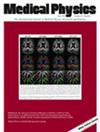Development of a respiratory-gated computed tomography system for in-vivo murine imaging
Abstract
Background
Respiratory motion poses a critical challenge in small animal lung imaging with micro-computed tomography (µCT). Contact sensors, when utilized as respiratory gating devices, can introduce beam-hardening artifacts and degrade image quality.
Purpose
This study is to develop a respiration-gated computed tomography (CT) system utilizing a non-contact laser displacement sensor for in vivo murine imaging.
Methods
The gating system comprises an x-ray beam shutter and a non-contact laser displacement sensor. The shutter controls the beam on and off during image acquisition, while the laser sensor converts thoracic surface displacement into a respiratory signal. The system's switch latency and measurement accuracy were assessed. Then, the gating system was utilized to analyze the respiratory patterns of animals (four groups and nine mice per group) anesthetized with varying isoflurane concentrations (1.0% to 2.5%). The external respiratory signal from the laser was compared with the diaphragm motion extracted from x-ray projections to analyze the delay between the two signals. Finally, eight mice were selected for retrospective and prospective gating imaging, respectively, and a variable number of landmarks, including the diaphragm, blood vessels, and bronchioles, were used to evaluate the image blur.
Results
The system's turn-on and turn-off latencies were 31.4 ± 4.9 ms and 32.6 ± 2.8 ms, respectively. The Pearson correlation test showed a strong correlation between the laser signal and the trajectory of the dynamic phantom (R = 0.99). In all four groups, a delay of approximately 200 ms was observed for the internal signal entering the end-expiration (EE) phase when compared with the external signal and was accounted for by a “delayed gating” strategy. Retrospective gating studies demonstrated that the slopes of the intensity across the diaphragm in images obtained without gating, with traditional gating, and with delayed gating were 21.5 ± 5.5, 41.5 ± 6.0, and 72.5 ± 9.5 Hounsfield units (HUs) per pixel, respectively, with significant differences among them (p < 0.001). Compared to traditional gating, delayed gating reduced motion artifacts and improved the clarity of lung structures. In prospective gating studies, the intensity slope across the diaphragm for delayed gating was 72.4 ± 12.4 HU/pixel, significantly higher than in the no-gating condition, which was 20.9 ± 4.1 HU/pixel (p < 0.001).
Conclusions
The analysis of mouse respiratory patterns revealed a time delay between the internal and external respiratory signals. The non-contact respiratory gating system combined with the delayed gating strategy can effectively reduce motion blur and enhance the visibility of fine structures and therefore can be applied to enhance the ability of µCT in quantitative lung imaging, such as in the early detection and precise differentiation of lung lesions.

 求助内容:
求助内容: 应助结果提醒方式:
应助结果提醒方式:


